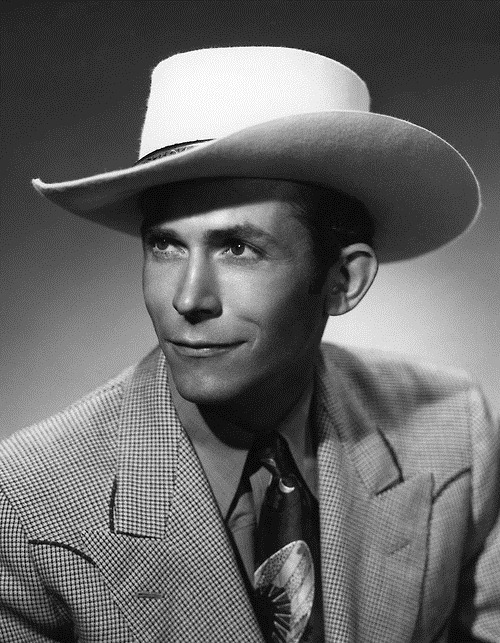By Katherine Cole

I always think Hank Williams appears so frail in comparison to the robust, chiseled country stars of today, but don’t let those looks fool you. Despite battles with illness and drug and alcohol addiction that lead to a career cut short by his death at 29, Hank had a career that today’s stars can only dream of. In six short years, Hank Williams wrote and recorded only 66 songs under his own name (he also recorded as “Luke the Drifter”, but that’s for another day)–but of those, an incredible 36 were Top Ten hits and 11 went all the way to Number One on the equivalent of today’s Billboard Country Chart.
Let that sink in for a minute. 6 years, 66 six songs, 36 top ten hits. 11 number ones. So, you could break that down to an album a year for six years. 6 top ten hits each year, and two of those going to number one. And he wrote all but one. Oh, and all those number-one songs are considered standards today. How many of hit makers today (in any genre) can claim that?
Born in Mount Olive, Alabama on September, 17, 1923, Hiram “Hank” Williams was a shy and sickly child. He was born with a spinal condition (believed to be spina bifida, but never diagnosed) which meant he’d never be able to work a farming or factory job or do any kind of manual labor. Good thing his musical talent showed itself early, with Hank learning gospel songs in church, traditional folk and country songs from his neighbors. He also learned the blues from a local African-American street musician, who also taught him the basics of playing the guitar.
He must have been a quick study, because young Hank Williams was entering local talent contests soon after he moved to Montgomery, Alabama (the big city!) with his mother in 1937. Ten years later, when he was only 23, Hank had his first hit, “Move It On Over.” Two years later, at 25, Hank hit it big with “Lovesick Blues” (which he didn’t write) and was honored with an invitation to join the Grand Ol’ Opry—an even bigger deal in 1949, than it is today. For the next few years, Hank was THE MAN–releasing a string of hits that included the now classic songs “I’m So Lonesome I Could Cry,” “Honky Tonkin’,” “Your Cheatin’ Heart” and “Jambalaya” and “I Can’t Help It (If I’m Still In Love With You).”
And while Hank Williams couldn’t be more country, his songs can’t be stuck in a box and labeled one style or another. They’ve been hits when pop, gospel or blues singers. One of Tony Bennett’s biggest hits was his cover of “Cold Cold Heart,” but as he explained in this video, it almost didn’t happen!
Even with all his success, Hank Williams wasn’t happy. The constant traveling was difficult on his back and kept him in pain. He hoped that spinal surgery would help, but it only made things worse. Hank turned to drugs and alcohol to ease the pain and that’s never the answer. He began missing shows. Soon he lost his wife (mother to son Hank Williams, Jr.) and was kicked off the Grand Ol’ Opry. And while he was still writing and releasing hit records, Hank Williams was proving to be an unreliable performer—showing up late for gigs or not at all. Soon, his bookings started dropping off and instead of playing the big joints, it was back to the beer gardens and dance halls.
At the end of 1952, things might have been looking up. “Jambalya” was one of the biggest hits of the year. Hank decided to go home to Montgomery and recuperate. But he also decided to keep two dates that were on his schedule—New Year’s Eve in Charleston, West Virginia and New Year’s Day in Canton, Ohio. It makes sense that he’d want to play those, they’d be well-paying gigs. But, in an ending befitting a character in one of his songs, Hank Williams died alone, in the back of a Cadillac en route to his Charleston shows, surrounded by sheet music, beer cans and whiskey bottles. He was only 29.
Sixty years after his death and on what would have been his 90th birthday, Hank Williams has not been forgotten. He is still an icon in American music, his songs rediscovered by every generation. They pop up in movie soundtracks like Forrest Gump and Steel Magnolias and have been licensed to television programs in almost every country around the world.
There are countless hits collections and boxed sets out there–ranging from simple ones that include only the Number One hits to treasure troves with live radio broadcasts and concerts. And “The Lost Notebooks of Hank Williams” features lyrics Hank left behind turned into finished songs by artists including Norah Jones, Bob Dylan and Jack White.
And if you’d like to retrace Hank Williams’ last ride, hop in and ride along with singer-songwriter and journalist Peter Cooper. He did just that in this haunting story from a few years ago. You can follow that up with a scrubbed up and fictionalized film version of the story–it’s called “The Last Ride.”
By the way, I have an every changing list of my top five Hank Williams songs. Today, “Your Cheatin’ Heart” is atop the list (I have no idea where it will be tomorrow). You?
